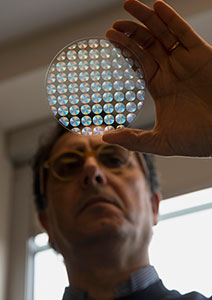Aug 21 2020
Human beings have mastered the art of refracting light for over five centuries—by molding glass into lenses and then integrating or bending those lenses to enlarge and clarify images either far-off or close-up.
 Giuseppe Strangi views a metalens array. Image Credit: Case Western Reserve University.
Giuseppe Strangi views a metalens array. Image Credit: Case Western Reserve University.
However, in the past 10 years or so, a research team, under the guidance of a Harvard University researcher Federico Capasso, has started to redefine the field of optics by designing flat optics metasurfaces.
They used an array of millions of small, transparent, and microscopically thin quartz pillars to diffract and shape the flow of light in a way that is relatively the same as a glass lens, but without the irregularities that naturally tend to restrict the glass.
The World Economic Forum (WEF) had selected the technology among the top 10 Emerging Technologies in 2019, which demonstrated that such increasingly clearer and smaller lenses would soon be integrated into optical-fiber lines, sensors, camera phones, and medical imaging devices, like endoscopes.
According to the WEF, “Making the lenses used by mobile phones, computers and other electronic devices smaller has been beyond the capabilities of traditional glass cutting and glass curving techniques. These tiny, thin, flat lenses could replace existing bulky glass lenses and allow further miniaturization in sensors and medical imaging devices.”
Making Metalenses “Reconfigurable”
Giuseppe Strangi, a physics professor from Case Western Reserve University, and collaborators from Harvard University, have now taken a step to make such “metalenses” even more beneficial—by rendering them reconfigurable.
To achieve this feat, the team harnessed nanoscale forces to infiltrate liquid crystals between those tiny pillars, enabling them to mold and diffract the light in entirely different ways—that is, “tuning” the focusing power, stated Strangi.
Moreover, liquid crystals are particularly useful because they can be exploited optically, magnetically, electrically, or thermally, which leads to the possibility for the reconfigurable or flexible lenses.
We believe that this holds the promise to revolutionize optics as we know it since the 16th century.
Giuseppe Strangi, Professor, Department of Physics, Case Western Reserve University
Strangi’s Nanoplasm Lab at Case Western Reserve University analyzes “extreme optics” as well as the “interaction of matter and light at nanoscale,” among other kinds of matters.
Until now, as soon as a glass lens is molded into a stiff curve, it could bend the light only in one way, unless physically moved or integrated with other lenses, added Strangi.
But metalenses changed all that, because they enable scientists to design the wavefront by managing amplitude, phase, and polarization of the light.
Now, by managing the liquid crystal, the team was able to take this new group of metalensses towards new technological and scientific endeavors to produce reconfigurable structured light.
This is just the first step, but there are many possibilities for using these lenses, and we have already been contacted by companies interested in this technology.
Giuseppe Strangi, Professor, Department of Physics, Case Western Reserve University
The study reporting this major innovation was published in the Proceedings of the National Academy of Sciences in early August 2020.
Strangi teamed up with many other scientists in Europe and the United States, including fellow researchers Andrew Lininger and Jonathan Boyd from Case Western Reserve University; Giovanna Palermo from the Universita’ della Calabria in Italy; and Capasso, Alexander Zhu, and Joon-Suh Park from the John A. Paulson School of Engineering and Applied Sciences at Harvard University.
According to Lininger, part of the issue with present applications of metasurfaces is that their shape is already fixed at the point of production; however, “by enabling reconfigurability in the metasurface, these limitations can be overcome.”
Capasso, who first developed the flat optics research field and also published a study on metalenses in 2014, credited Strangi for the concept of infiltrating the metalenses with liquid crystals, and according to him, this breakthrough brings scientists one step closer to even bigger things.
Our ability to reproducibly infiltrate with liquid crystals state-of-the art metalenses made of over 150 million nanoscale diameter glass pillars and to significantly change their focusing properties is a portent of the exciting science and technology I expect to come out of reconfigurable flat optics in the future.
Federico Capasso, Scientist, Harvard University
Journal Reference
Lininger, A., et al. (2020) Optical properties of metasurfaces infiltrated with liquid crystals. Proceedings of the National Academy of Sciences. doi.org/10.1073/pnas.2006336117.